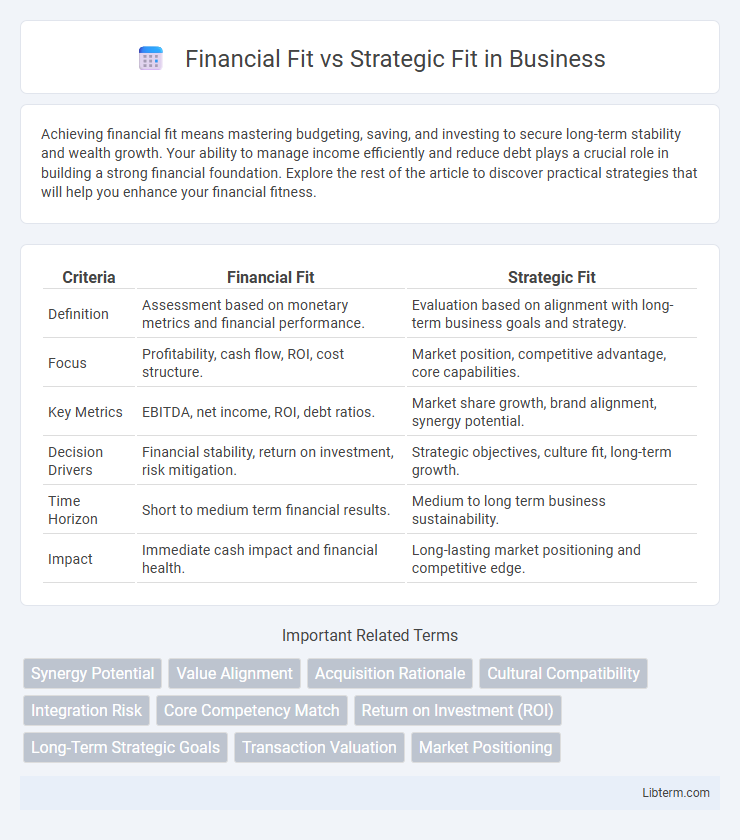Achieving financial fit means mastering budgeting, saving, and investing to secure long-term stability and wealth growth. Your ability to manage income efficiently and reduce debt plays a crucial role in building a strong financial foundation. Explore the rest of the article to discover practical strategies that will help you enhance your financial fitness.
Table of Comparison
| Criteria | Financial Fit | Strategic Fit |
|---|---|---|
| Definition | Assessment based on monetary metrics and financial performance. | Evaluation based on alignment with long-term business goals and strategy. |
| Focus | Profitability, cash flow, ROI, cost structure. | Market position, competitive advantage, core capabilities. |
| Key Metrics | EBITDA, net income, ROI, debt ratios. | Market share growth, brand alignment, synergy potential. |
| Decision Drivers | Financial stability, return on investment, risk mitigation. | Strategic objectives, culture fit, long-term growth. |
| Time Horizon | Short to medium term financial results. | Medium to long term business sustainability. |
| Impact | Immediate cash impact and financial health. | Long-lasting market positioning and competitive edge. |
Introduction to Financial Fit and Strategic Fit
Financial Fit assesses whether a merger or acquisition aligns with the acquiring company's financial capacity, evaluating metrics such as return on investment, cost synergies, and cash flow impact. Strategic Fit examines how well the target company complements the acquirer's long-term goals, market position, and competitive advantage, focusing on product offerings, customer segments, and geographic expansion. Both fits are critical for ensuring sustainable growth and maximizing shareholder value in corporate transactions.
Defining Financial Fit: Key Indicators
Financial Fit is defined by key indicators such as profitability ratios, return on investment (ROI), and cash flow stability, which measure a company's economic viability and financial health. Evaluating financial fit involves analyzing liquidity ratios like current ratio and quick ratio to ensure sufficient short-term assets cover liabilities. Debt-to-equity ratio and earnings per share (EPS) also provide critical insights into a company's leverage and shareholder value, crucial for merger and acquisition decisions.
Understanding Strategic Fit: Core Elements
Strategic fit involves aligning a company's resources, capabilities, and objectives with the external environment to achieve competitive advantage and long-term success. Core elements include market compatibility, complementary strengths, and shared vision, ensuring that the combined entities create more value together. Understanding strategic fit enables effective decision-making in mergers, acquisitions, and partnerships, optimizing synergy and sustainable growth.
Importance of Financial Fit in Decision-Making
Financial Fit is crucial in decision-making because it ensures the alignment of investment opportunities with the company's financial resources and risk tolerance, directly impacting profitability and sustainability. Evaluating financial metrics such as return on investment (ROI), cash flow projections, and capital structure ensures decisions support long-term fiscal health. Ignoring Financial Fit can lead to resource misallocation, increased debt burdens, and impaired organizational performance.
The Role of Strategic Fit in Business Success
Strategic fit aligns a company's resources, capabilities, and market opportunities to achieve long-term competitive advantage and sustainable growth, which often surpasses the short-term gains emphasized by financial fit. This alignment enhances value creation by ensuring that mergers, acquisitions, or partnerships complement core business objectives and operational strengths. Firms with strong strategic fit consistently outperform in market positioning, innovation, and resilience against industry disruptions, driving superior overall business success.
Financial Fit vs Strategic Fit: Key Differences
Financial fit evaluates a company's ability to meet financial goals through metrics like profitability, cash flow, and return on investment, emphasizing quantitative measures. Strategic fit assesses alignment with long-term objectives, market positioning, and competitive advantage, focusing on qualitative factors such as corporate culture and growth potential. The key differences lie in financial fit's focus on numbers and short-term financial health versus strategic fit's emphasis on sustainable competitive synergy and future growth.
Examples of Financial Fit in Mergers and Acquisitions
Financial fit in mergers and acquisitions refers to the alignment of financial metrics such as valuation, cash flow, and debt capacity between the acquiring and target companies. For example, when a company with strong cash reserves acquires a target with steady income but undervalued shares, the transaction demonstrates financial fit by improving overall return on investment and liquidity management. Another instance is when firms with complementary capital structures merge to optimize debt financing and reduce cost of capital, enhancing shareholder value.
Strategic Fit in Practice: Case Studies
Strategic fit in practice is demonstrated through case studies such as Disney's acquisition of Pixar, where aligning corporate cultures and creative visions maximized long-term value beyond immediate financial gains. Samsung's vertical integration strategy showcases strategic fit by synchronizing its supply chain and innovation capabilities to strengthen competitive advantage in global markets. These examples highlight that successful strategic fit involves harmonizing organizational goals, resources, and market positioning to ensure sustainable growth rather than focusing solely on short-term financial metrics.
Balancing Financial Fit and Strategic Fit in Business Strategy
Balancing financial fit and strategic fit is crucial for sustainable business growth, ensuring that investment decisions not only meet financial performance metrics such as ROI and cash flow but also align with the company's long-term competitive positioning and core competencies. Enterprises that integrate financial analysis with strategic considerations like market expansion potential, innovation capability, and cultural alignment achieve higher resilience and value creation. This dual approach enables firms to allocate resources efficiently while adapting to dynamic market conditions and stakeholder expectations.
Conclusion: Choosing the Right Fit for Business Growth
Selecting between financial fit and strategic fit hinges on a company's long-term growth objectives and market positioning. Financial fit emphasizes immediate economic returns and cost efficiency, while strategic fit prioritizes alignment with core competencies and future innovation potential. Businesses aiming for sustainable growth often benefit from integrating both approaches to optimize resource allocation and competitive advantage.
Financial Fit Infographic

 libterm.com
libterm.com